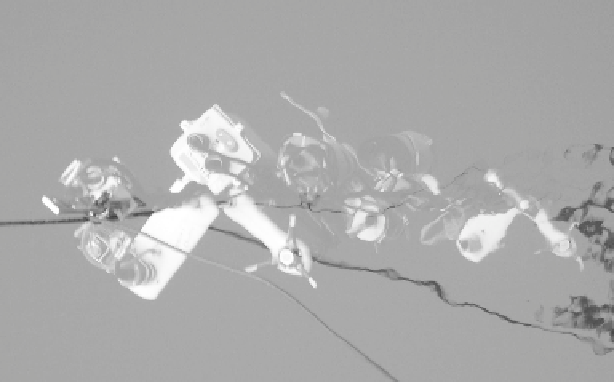Geoscience Reference
In-Depth Information
Fig. 3.2
Mast with two TICs equipped with SonTek 5MHz ADVOcean current meters, near the
surface during a deployment from the Baltic room of the R/V
Nathaniel B. Palmer
during the
MaudNESS project, 2005
rotors will turn in currents down to about 1cms
−
1
, when they are arranged along
orthogonal axes, we have found that it takes a mean current of about 5cms
−
1
to
keep all three rotors spinning, hence this imposes a practical minimum threshold
forthree-dimensionalvelocitymeasurement.Overthe spanof severalexperiments,
we tried various other current measuring techniques including a laser-Doppler
velocimeter (LDV) and a high-frequency (10MHz) backscatter acoustic Doppler
velocimeter (ADV). For the LDV and 10-MHz ADV instruments we found that a
lack of optical and acoustic scatterers in the very clear polar mixed layers resulted
inlowsignal-to-noiseratios,whichseverelylimitedtheirusefulness.However,dur-
ing SHEBA, we tested a larger, 5-MHz version of the ADV (SonTek ADVOcean)
thatforthe mostpartmaintainedadequatesignal-to-noiseratios.Advantagesofthe
ADVincludea verylowcurrentthreshold(determinedagainbythesignal-to-noise
ratio)andthatitsamplesavolume(anellipsoidwithmajoraxesabout1
2cm)that
isseparatedfromthecurrentmeterapparatusbyabout15cm,significantlyreducing
flow disturbance. We exploited the low current threshold of the 5-MHz ADV to
make credible estimates of momentum, heat, and salt flux in a gentle tidal current
underfastice inVanMijenFjord,Svalbard,in2001(McPheeetal. 2008,in press),
and in several projects since, including a deployment from the Baltic room of the
R/V
Nathaniel B. Palmer
duringMaudNESS(Fig.3.2).
×
3.2.3 Momentum and Scalar Flux Measurements
The main contribution of the TIC deployments has been to directly measure the
covariance of vertical velocity with deviatory horizontal velocity, temperature,
and salinity components. The Reynolds decomposition combined with Taylor's

